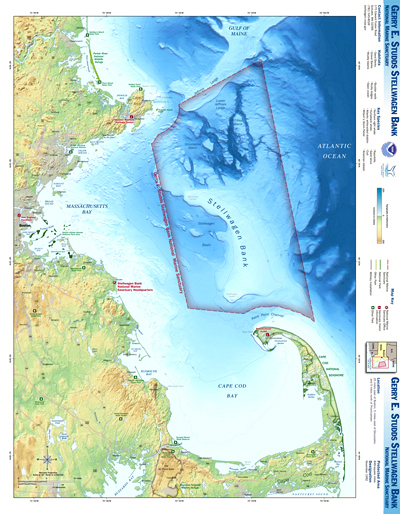A Look Back Towards the Future
A first-of-a-kind, three-year historical fisheries study by UNH researchers finds annual catch levels in the Gulf of Maine’s Stellwagen Bank have declined fifty percent since 1900
 |
|
| One of many advertisements of the federal government to market net-trawled bycatch. Photo courtesy of United States Fisheries Heritage Digital Collection |
Rather than let the bounty go to waste, the fishing industry enlisted the help of the U.S. government to get the bycatch to market. The government crafted a series of broadsheets designed to whet the appetite of American housewives: “Low Priced And Excellent Salted And Smoked, Contains No Bones, Try It, Shark,” proclaimed one advertisement. A World War I era broadsheet pictured a skate and trumpeted, “Favorite Food Fishes Of Our Allies, Becoming Appreciated By Ourselves. Recommended As Excellent And Nutritious By The U.S. Bureau of Fisheries.”
Rich historical details like these are part of the “Stellwagen Bank Marine Historical Ecology Final Report,” a comprehensive study just published by researchers from the Ocean Process Analysis Laboratory (OPAL) at the UNH Institute for the Study of Earth, Oceans, and Space.
 | |
| Historic place names of fishing grounds and undersea features superimposed on bathymetric map of Stellwagen Bank National Marine Sanctuary. Photo courtesy of NOAA. |
“Fisheries science has typically employed a single-species approach, and few studies have examined marine ecosystems both holistically and historically,” Claesson says adding, “for the first time, this study took a multi-species, historical approach.”
Assessments presented in the report of late 19th- and early 20th-century fisheries on the 842-square-mile Stellwagen Bank provide baselines for comparison with current ecosystem conditions. “Through comparative analysis, long-term trends have been identified that may be useful to direct future management decisions. Our historical research revealed significant declines in animal diversity and abundance, as well as major shifts in the species composition of Stellwagen’s fisheries,” the report states. Its findings challenge currently established baselines “and should influence the direction of management actions needed to improve overall ecosystem integrity.”
The report illustrates how history and ecology reinforce the long-term significance of the sanctuary’s ecosystems and marine resources to the broader Gulf of Maine system. At the same time, it highlights the historical role of Stellwagen Bank’s marine resources in the development and well-being of Gulf of Maine coastal communities.
 |
|
The Stellwagen report grew out of work being done at OPAL on the decade-long Census of Marine Life and its History of Marine Animal Populations or HMAP project. HMAP is a global, interdisciplinary research initiative studying past ocean life and human interaction with the sea. Some 100 researchers from around the world are involved in the effort.
One interesting finding was the progressive influence technology and technology change exerted on the Stellwagen ecosystem. As particular fisheries resources decline over time, Claesson explains, “people come up with new technologies to increase harvest, but that only works for a short time. Then harvest declines again or the system crashes. The technology is improved on old grounds or the fishing is moved elsewhere and the cycle begins once more. With each iteration ecosystems decline further and eventually change can be measured in orders of magnitude." Claesson adds, "If you only looked at one short period of technological change, an increase in catch might lead you to believe that things were going pretty well. But when you look farther back in time, the cycles of peaks and drops show conditions just getting worse and worse.”
 | |
 | |
| |
The report will be posted on the web as part of the NOAA National Marine Sanctuaries Conservation Series, which provides a forum for publication and discussion of the complex issues the National Marine Sanctuary Program faces.
by David Sims, Science Writer, Institute for the Study of Earth, Oceans, and Space. Published in Summer 2010 issue of EOS .
